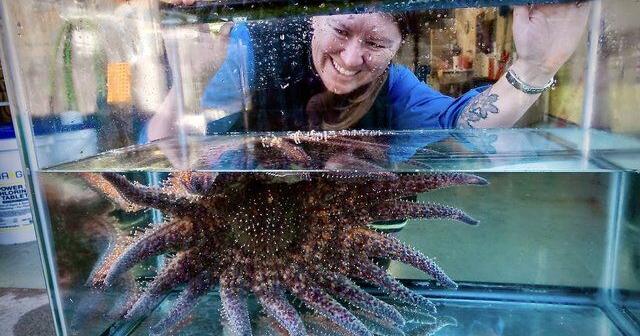The mystery behind a catastrophic disease that caused the massive die off of billions of sea stars along the West Coast and confounded scientists for more than a decade is solved.
First noticed by scuba divers in 2013, sea star wasting disease went on to be the largest marine epidemic ever documented. The disease infected 20 different species the length of the coast from Alaska to Mexico, pushing sunflower sea stars in particular — and the vital kelp forests that rely on them — to the cusp of extinction in southern US waters.
The discovery is giving new hope that further outbreaks of the devastating disease can be contained or prevented.
The cause of the wasting disease is strain of the bacterium Vibrio pectenicida, a four-year cross-border research effort by scientists from the Hakai Institute, the University of British Columbia (UBC) and the University of Washington discovered.
The microbial culprit — Vibrio pectenicida strain FHCF-3 — lays waste to sea stars, first causing white lesions that rapidly eat away at the many-armed creatures before reducing them to mush within two weeks, said senior study author Alyssa Gehman, a marine disease ecologist with the Hakai Institute and the University of British Columbia.
Identifying the bacterium as the cause of the wasting was a complete shock, Gehman said.
“The results completely blew me away. It was not at all what we thought was actually going to end up being the causative agent,” she said.
Vibrio bacteria — also known for causing diseases in organisms such as shellfish and cholera in humans — was considered in research during earlier stages of the sea star epidemic, but is difficult to grow in the lab and so was inadvertently ruled out as a pathogen.
However, the collective of researchers involved in the study had decided to go back to the drawing board and start analyzing as many possible pathogens as possible, including viruses.
The breakthrough came when the team zeroed in on high levels of the bacteria in sea star coelomic fluid, the vascular liquid that plays a similar role to blood in the human circulatory system.
Using coelomic fluid to identify potential pathogens removed all the extra bacteria and viruses found on the outside of the animal that might therefore be found in sea star tissue samples, but that are not involved in causing the disease, Gehman said.
“If you’re looking for a needle in a haystack, it’s handy to have less hay,” she said.
The discovery has shifted the focus from despair to hope, with exciting scientific opportunities to manage and mitigate the disease’s effects, said lead author Melanie Prentice, an evolutionary ecologist with Hakai and UBC.
“Overnight we went from a scenario where we didn’t have the capacity to manage or understand the disease to a position where we have so much opportunity to do something about it,” Prentice.
Potential measures include the development of diagnostic testing tools that will allow scientists to test marine habitat to determine which areas are disease-free for the reintroduction of sea stars, said Prentice.
As with the virus that caused the Covid-19 pandemic, there’s likely more than one strain of the bacterium causing disease in sea stars, Prentice said. By sequencing and comparing various genomes, researchers can get a better picture of how the disease spread and evolved, as well as potential future impacts it could have on marine ecosystems.
Using genetics to identify and breed sunflower sea stars resistant to the bacterium is an exciting possibility, she said.
Sunflower sea stars (Pycnopodia helianthoides) are voracious sea floor predators as wide as a bicycle wheel that play a key role in the ecosystem, and their dramatic decline has had far-reaching ecological impacts, Prentice said. An estimated 5.75 billion sunflower sea stars on the Pacific Coast — over 90 per cent of their global population — have succumbed to the disease, with only isolated enclaves remaining in BC and Alaskan waters.
With sunflower stars gone, their main prey — sea urchins — have proliferated and over-consumed kelp forests, Prentice said. Kelp forests store carbon, offer key habitat to lots of marine life and act as nurseries for fish that humans rely on.
“Losing a sea star goes beyond the loss of that single species,” she said.
Now that the pathogen is identified, scientists can figure out what triggered the outbreak and continue to explore if warming waters tied to climate change caused the bacterium to become lethal.
As coastal ecosystems continue to face warmer and more acidic waters and increasing biodiversity loss, the study results are good news, the scientists said.
“It’s just really exciting to see that our puzzle-solving has paid off,” said Prentice.
“This is a story that has really impacted people. Everyone knows that these sea stars are gone, and they miss them.”
Rochelle Baker / Local Journalism Initiative / Canada’s National Observer

